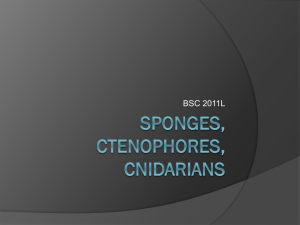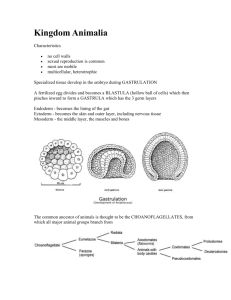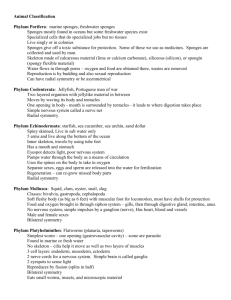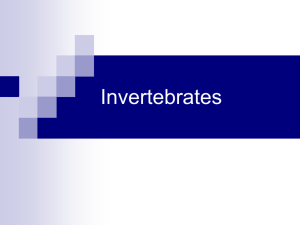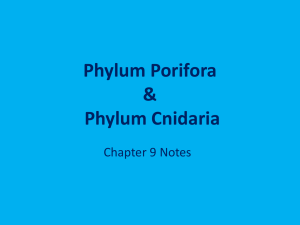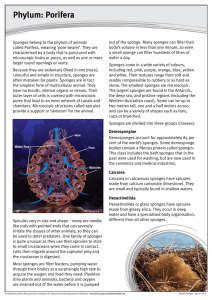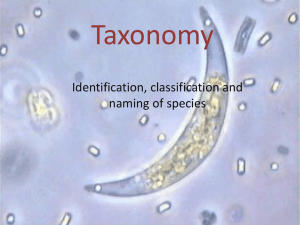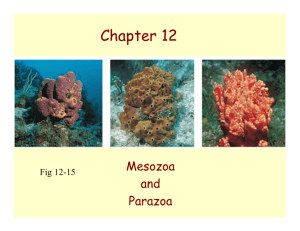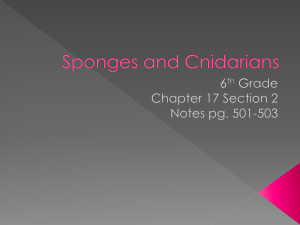Chapter 14
advertisement
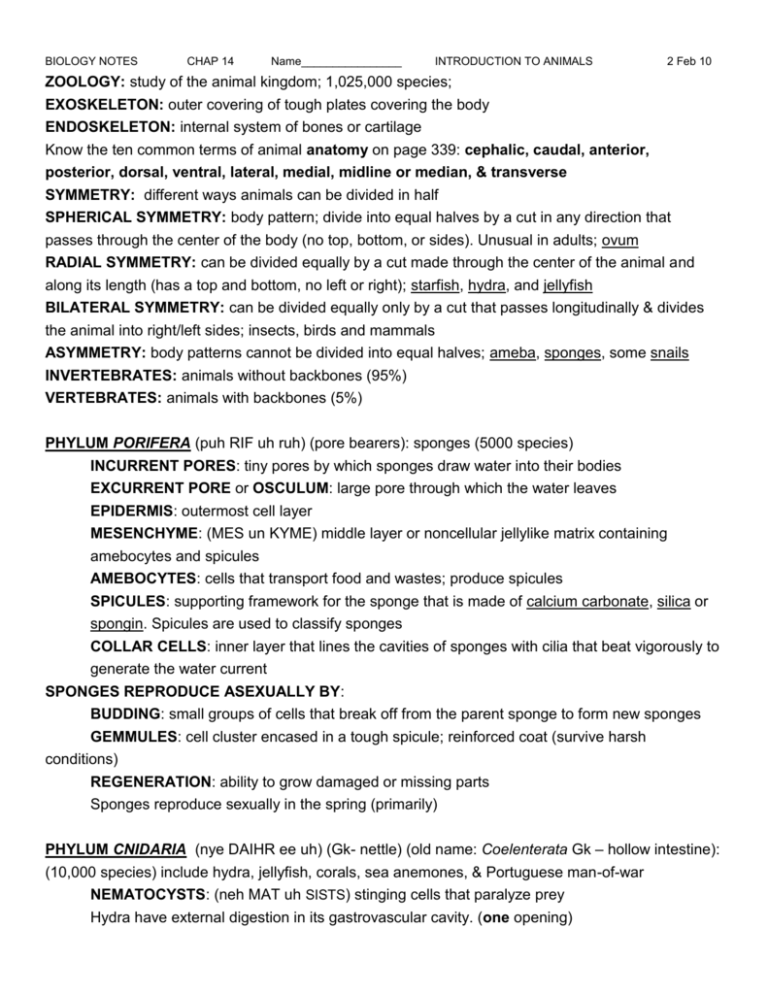
BIOLOGY NOTES CHAP 14 Name________________ INTRODUCTION TO ANIMALS 2 Feb 10 ZOOLOGY: study of the animal kingdom; 1,025,000 species; EXOSKELETON: outer covering of tough plates covering the body ENDOSKELETON: internal system of bones or cartilage Know the ten common terms of animal anatomy on page 339: cephalic, caudal, anterior, posterior, dorsal, ventral, lateral, medial, midline or median, & transverse SYMMETRY: different ways animals can be divided in half SPHERICAL SYMMETRY: body pattern; divide into equal halves by a cut in any direction that passes through the center of the body (no top, bottom, or sides). Unusual in adults; ovum RADIAL SYMMETRY: can be divided equally by a cut made through the center of the animal and along its length (has a top and bottom, no left or right); starfish, hydra, and jellyfish BILATERAL SYMMETRY: can be divided equally only by a cut that passes longitudinally & divides the animal into right/left sides; insects, birds and mammals ASYMMETRY: body patterns cannot be divided into equal halves; ameba, sponges, some snails INVERTEBRATES: animals without backbones (95%) VERTEBRATES: animals with backbones (5%) PHYLUM PORIFERA (puh RIF uh ruh) (pore bearers): sponges (5000 species) INCURRENT PORES: tiny pores by which sponges draw water into their bodies EXCURRENT PORE or OSCULUM: large pore through which the water leaves EPIDERMIS: outermost cell layer MESENCHYME: (MES un KYME) middle layer or noncellular jellylike matrix containing amebocytes and spicules AMEBOCYTES: cells that transport food and wastes; produce spicules SPICULES: supporting framework for the sponge that is made of calcium carbonate, silica or spongin. Spicules are used to classify sponges COLLAR CELLS: inner layer that lines the cavities of sponges with cilia that beat vigorously to generate the water current SPONGES REPRODUCE ASEXUALLY BY: BUDDING: small groups of cells that break off from the parent sponge to form new sponges GEMMULES: cell cluster encased in a tough spicule; reinforced coat (survive harsh conditions) REGENERATION: ability to grow damaged or missing parts Sponges reproduce sexually in the spring (primarily) PHYLUM CNIDARIA (nye DAIHR ee uh) (Gk- nettle) (old name: Coelenterata Gk – hollow intestine): (10,000 species) include hydra, jellyfish, corals, sea anemones, & Portuguese man-of-war NEMATOCYSTS: (neh MAT uh SISTS) stinging cells that paralyze prey Hydra have external digestion in its gastrovascular cavity. (one opening) Hydra reproduce asexually by budding and regeneration and sexually in the fall or winter Hydra’s nerve net allows its behavioral food and touch responses; simpler than ganglion Cnidarians take the form of a polyp (sessile stage) or a medusa (motile stage): POLYP: (PAHL ip) tubular w/ a mouth and tentacles at one end and a basal disc at other MEDUSA: (muh DOO suh) an expanded bell-shaped body Cnidarians have a digestive system with one opening PHYLUM PLATYHELMINTHES: (PLAT ih hel MIN theez) flatworms; planarians - hermaphroditic (hur MAF ruh DIT ik) have both sexual organs; have digestive system with one opening; 3 cell layers PARASITIC FLATWORMS: have a thick tegument (protective body covering) Flukes: Human liver fluke; larval in snails; cysts in fish Tapeworms: from eating uncooked pork, beef or fish (59 ft), bear, deer or raccoons PHYLUM NEMATODA: (NEM uh TOH duh) round worms; so common, abundant and found in nearly every environment that they are used as indicators of pollution. Most reproduce sexually only ASCARIS: (AS kuh ris) intestinal roundworm; male smaller, hooked end; 200,000 eggs/day HOOKWORM: 3 factors spread it: going barefoot, careless sewage disposal, warm soil; feeds on blood and tissue fluids flowing from the wound it makes PINWORM: childhood worm; spread by ingesting eggs (can float in the air) TRICHINA WORM: (trih KYE nuh) uncooked pork; forms larval cysts in human muscle tissue PHYLUM ANNELIDA: (little rings) The segmented worms EARTHWORM: remove metabolic wastes through the nephridia (neh FRID ee uh); ‘brain’ has two ganglia (GANG glee uh) (masses of nervous tissue) LEECHES: still have some medical uses PHYLUM MOLLUSCA: (muh LUS kuh) most have gills for respiration VALVE: shell of a mollusk VISCERAL HUMP: (VIS ur ul) part of the mollusk’s body that contains its heart, digestive, and excretory organs and is often covered by the mantle CLASS BIVALVA: two-shelled mollusks; example - clams, oysters, mussels, & scallops CLASS GASTROPODA: (gas TRAHP uh duh) stomach-footed mollusks; snails, slugs, nudibranchs (NOO duh BRAHNK) CLASS CEPHALOPODA: (SEF uh LAHP uh duh) head-footed mollusks; squid, octopus, nautilus & cuttlefish PHYLUM ECHINODERMATA: (ih KYE nuh dur MAH tuh) spiny skinned; includes sea stars (starfish), sea urchins, sea lilies and sea cucumbers. They have radial symmetry (no left or right) Starfish have water-vascular system (series of canals & tubes) for locomotion & food capture

